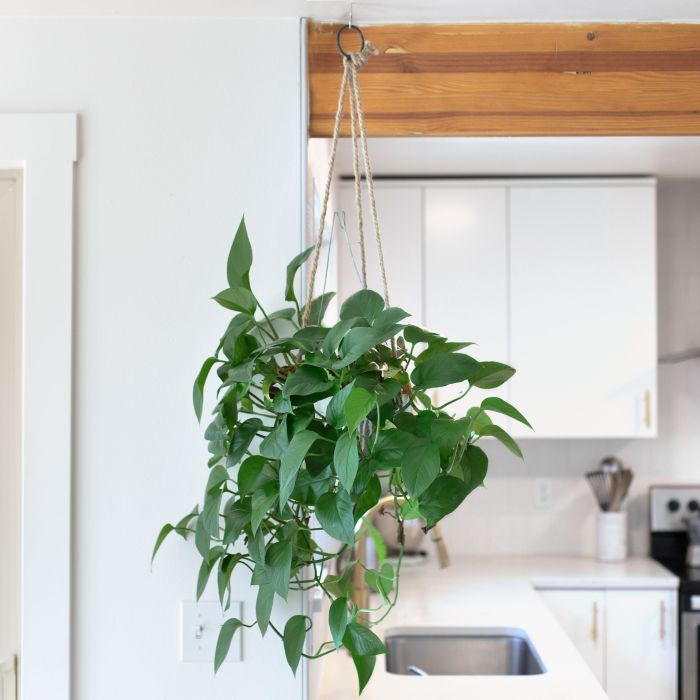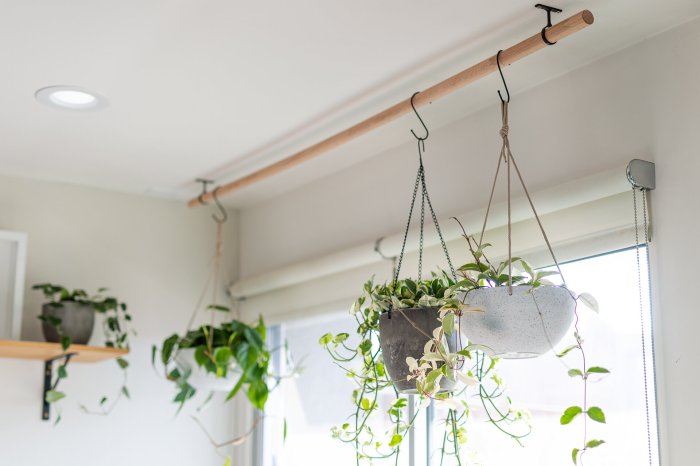Hanging plants are making a grand entrance in the world of home décor, captivating hearts with their graceful presence. Whether you’re a seasoned plant enthusiast or a novice seeking to bring life to your space, this guide to hanging plants to buy will lead you on a verdant journey, providing invaluable insights into their types, care, and styling.
From cascading trails of pothos to blooming wonders like fuchsias, the world of hanging plants offers a treasure trove of options, each with its unique charm. As you delve into this guide, you’ll discover the secrets to choosing the perfect hanging plants for your home, ensuring their thriving presence for years to come.
Types of Hanging Plants: Hanging Plants To Buy

Hanging plants are a versatile and stylish way to add greenery to your home. They can be used to create a lush, tropical atmosphere, or to add a touch of elegance to a more formal space. There are many different types of hanging plants to choose from, each with its own unique look and care requirements.
Hanging plants can be divided into three main categories: trailing plants, vining plants, and flowering plants.
Trailing Plants
Trailing plants are those that have long, flowing stems that cascade over the edge of their pot. They are ideal for hanging baskets or wall-mounted planters. Some popular trailing plants include:
- Spider plant( Chlorophytum comosum): This easy-to-care-for plant produces long, arching stems with variegated leaves.
- Pothos( Epipremnum aureum): This vine-like plant has heart-shaped leaves that come in a variety of colors, including green, yellow, and white.
- String of pearls( Senecio rowleyanus): This delicate plant has long, trailing stems with small, round leaves that resemble pearls.
Vining Plants
Vining plants are those that have long, climbing stems that can reach up to several feet in length. They are ideal for trellises or other structures that they can climb on. Some popular vining plants include:
- English ivy( Hedera helix): This classic vining plant has dark green leaves with five lobes.
- Philodendron( Philodendron spp.): This genus of plants includes a wide variety of vining species, with leaves that come in a variety of shapes and colors.
- Hoya( Hoya spp.): This genus of plants includes a variety of vining species, with waxy leaves and fragrant flowers.
Flowering Plants
Flowering hanging plants are a great way to add a touch of color and fragrance to your home. Some popular flowering hanging plants include:
- Fuchsia( Fuchsia spp.): This showy plant produces clusters of bell-shaped flowers in a variety of colors.
- Petunia( Petunia spp.): This popular bedding plant also makes a great hanging plant, with its trumpet-shaped flowers in a variety of colors.
- Calibrachoa( Calibrachoa spp.): This plant is similar to petunias, but it has smaller flowers and a more compact growth habit.
Factors to Consider When Choosing Hanging Plants
Selecting the perfect hanging plants for your home requires careful consideration of several key factors. Understanding the plant’s light requirements, watering needs, growth rate, and size and shape will help ensure a thriving and aesthetically pleasing addition to your living space.
Light Requirements
Determine the amount of sunlight available in the area where you plan to hang the plant. Some plants, such as ferns and spider plants, thrive in low-light conditions, while others, like succulents and geraniums, prefer bright, indirect light. Matching the plant’s light requirements to the available light will promote healthy growth and prevent issues like leaf burn or yellowing.
Watering Needs
Consider the frequency with which you are able to water your plants. Some hanging plants, like pothos and philodendrons, are relatively drought-tolerant and require infrequent watering. Others, such as fuchsias and begonias, need more regular watering to maintain their lush foliage.
Growth Rate
The growth rate of a hanging plant will influence how often you need to prune or repot it. Fast-growing plants, like ivy and coleus, may require more frequent maintenance to keep them under control. Slow-growing plants, such as orchids and succulents, can go longer periods without needing attention.
Size and Shape
The size and shape of a hanging plant should complement the space where it will be placed. Smaller plants, like trailing succulents or ferns, are suitable for narrow spaces or windowsills. Larger plants, such as cascading ivy or hanging baskets of flowers, can create a dramatic focal point in a room.
Care and Maintenance of Hanging Plants
Hanging plants bring a touch of greenery and vibrancy to any space. However, providing proper care and maintenance is crucial to ensure their health and longevity.
Watering Techniques
Watering hanging plants can be tricky due to their elevated position. Use a watering can with a long spout to reach the soil directly. Water thoroughly until excess water drains from the bottom of the pot. Allow the soil to dry out slightly between waterings, especially during cooler months.
Before choosing which hanging plants to buy, it is important to determine the amount of sunlight the desired location receives. If direct sunlight is available, then consider hanging plants that thrive in such conditions. For more information on hanging plants that prefer direct sunlight, visit what hanging plants like direct sunlight . After selecting the right hanging plants, ensure they receive the appropriate amount of sunlight to maintain their health and beauty.
Fertilizing Schedules
Fertilize hanging plants every 2-4 weeks during the growing season (spring and summer) using a balanced liquid fertilizer diluted to half strength. Avoid over-fertilizing, as it can damage the plant’s roots.
Pruning Methods
Regular pruning helps keep hanging plants tidy and promotes new growth. Remove any dead or damaged leaves and stems. For bushier plants, pinch back the tips of stems to encourage branching.
Pest and Disease Control
Hanging plants are susceptible to pests and diseases like other plants. Regularly inspect your plants for signs of infestation or disease. Use insecticidal soap or neem oil to treat pests. For diseases, follow the instructions on commercial fungicides.
Styling Ideas for Hanging Plants
Hanging plants are a versatile way to add life and greenery to your home décor. They can be hung from ceilings, displayed on shelves, or used as room dividers. Here are a few creative ideas for incorporating hanging plants into your home décor:
Hanging from Ceilings
Hanging plants from ceilings is a great way to add a touch of greenery to a room without taking up floor space. You can hang plants from hooks, chains, or macrame hangers. Consider the height of the plant when choosing a hanger.
You don’t want the plant to be too high that it’s difficult to water or too low that it gets in the way.
Whether you’re a seasoned plant enthusiast or just starting to explore the world of greenery, hanging plants are a must-have for any home. These versatile plants add a touch of elegance and sophistication to any room, and they’re also a great way to add some extra greenery to your space.
If you’re looking for a hanging plant that will attract hummingbirds to your yard, be sure to check out the wide variety of hanging plants for hummingbirds available. From fuchsia to lantana, there are many different types of hanging plants that will provide a beautiful and welcoming environment for these tiny birds.
So, if you’re looking for a way to add some beauty and life to your home, be sure to consider adding a hanging plant or two to your décor.
Displaying on Shelves
Hanging plants can also be displayed on shelves. This is a great way to add a touch of greenery to a bookshelf or display cabinet. You can use hanging planters or simply place the plants on the shelves. If you’re using hanging planters, make sure they’re securely attached to the shelf.
Using as Room Dividers, Hanging plants to buy
Hanging plants can also be used as room dividers. This is a great way to create a sense of separation between two spaces without blocking the light. You can hang plants from the ceiling or from a wall-mounted plant hanger.
Hanging plants are a great way to add some greenery to your home, and there are many different types to choose from. Some popular hanging plants include pothos, spider plants, and ferns. If you’re not sure which hanging plant is right for you, you can do some research online to find the perfect one.
Once you’ve chosen your hanging plant, you’ll need to decide where to put it. Hanging plants can be placed in a variety of locations, including indoors and outdoors. If you’re planning on planting your hanging plant in the ground, you’ll need to make sure that it’s a type that can tolerate being planted in the ground.
Can you plant hanging plants in the ground ? You can find more information about this topic by clicking on the link provided. Once you’ve decided where to put your hanging plant, you’ll need to water it regularly and fertilize it occasionally.
With proper care, your hanging plant will thrive and add beauty to your home for years to come.
Choose plants that are tall and have a trailing habit, such as pothos or spider plants.
DIY Projects for Hanging Plants
For those looking to add a personal touch to their indoor gardening, creating your own hanging planters can be a rewarding and budget-friendly option. Here are a few popular DIY projects for hanging plants that are both stylish and functional:
Macrame Hangers
Macrame, an ancient art form that involves knotting cords or threads, can be used to create intricate and decorative hanging planters. With a variety of patterns and colors to choose from, macrame hangers can add a bohemian or eclectic touch to any space.
The knots can be adjusted to accommodate different pot sizes and shapes, making them versatile for various plants.
Woven Baskets
Woven baskets, often made from natural materials like jute, seagrass, or wicker, provide a rustic and organic aesthetic to hanging plants. The woven design allows for good air circulation, promoting plant health. They can be purchased pre-made or crafted by hand using simple weaving techniques.
The size and shape of the basket should be considered based on the plant’s growth habits.
Ceramic Pots
Ceramic pots are a classic and durable choice for hanging planters. They come in various shapes, sizes, and colors, allowing for customization to match any décor. Ceramic pots provide excellent insulation, helping to regulate soil temperature and moisture levels. When creating a hanging ceramic planter, it is important to ensure proper drainage by drilling holes in the bottom of the pot.
Closing Summary

Incorporating hanging plants into your home décor is not merely a trend but a transformative experience. With their ability to purify the air, reduce stress, and enhance aesthetics, these verdant wonders bring a touch of nature indoors, creating a sanctuary of tranquility and beauty.
Embrace the joy of hanging plants, and let their graceful presence elevate your home into a haven of natural elegance.
FAQ
What are the different types of hanging plants?
Hanging plants come in various forms, including trailing plants like pothos and spider plants, vining plants such as ivy and philodendron, and flowering plants like fuchsias and begonias.
How do I choose the right hanging plants for my home?
Consider factors such as light availability, watering needs, growth rate, and the desired size and shape when selecting hanging plants.
How do I care for hanging plants?
Provide appropriate watering, fertilize regularly, prune as needed, and monitor for pests and diseases to ensure the health of your hanging plants.